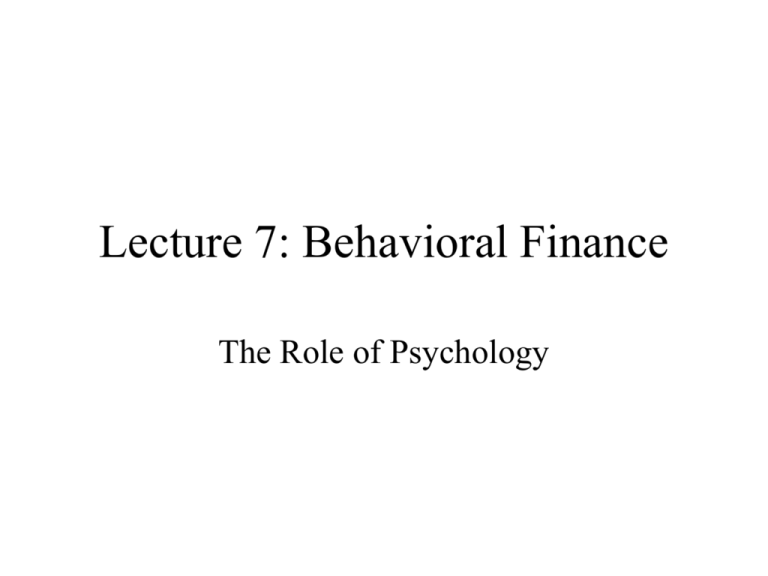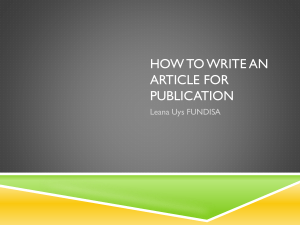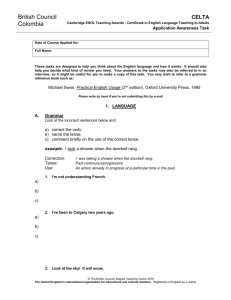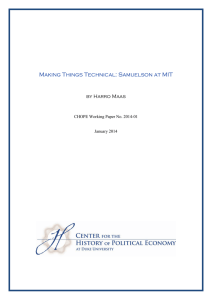Lecture 6: Behavioral Finance
advertisement

Lecture 7: Behavioral Finance The Role of Psychology Questionnaire, Part I Give 90% Confidence Interval 1. How much does the Statue of Liberty weigh, in tons? (entire steel-reinforced copper figure) 2. What is the 2000 population of Turkey? 3. How many square miles in Sahara Desert? 4. Endowment of Yale University as reported in 1998-9 Support of Education Survey? 5. How much, in dollars, does one receive if one wins the Pulitzer Prize (2001)? Questionnaire, Part II Give 90% Confidence Interval 6. US Population in first census (1790) 7. US Traffic fatalities New Years Day 1/1/98 8. Connecticut land area, square miles 9. Height of Mount Everest 10. 100-meter dash winner, time in seconds, 1896 Olympics Overconfidence From my October, 1987 Investor Survey: “Did you think at any point on October 19, 1987 that you had a pretty good idea when the market would rebound?” Institutional: 29% yes, Individual 28% yes Among buyers: 47%, 48% “If yes, what made you think you knew when a rebound would occur? Answers: “intuition,” “gut feeling,” “common sense” Prospect Theory • Kahneman and Tversky, Econometrica 1979 • Two elements, value function and weighting function • Elements replace utility function and probabilities in expected utility theory Samuelson’s Lunch Colleague • Paul Samuelson offered two-to-one odds to his colleague: colleague wins $200 if heads, loses $100 if tails. Colleague refused bet. • Samuelson asked him if he would take 100 such bets. Colleague said yes. • Samuelson proved mathematically that his colleague was not rational (from expected utility theory). [Scientia 98:108-13, 1963] Allais Paradox • Which do you prefer: 25% chance of winning $3000 and a 20% chance of winning $4000? [35%,65%] • Which do you prefer: 100% chance of winning $3000 or an 80% chance of winning $4000? [80%,20%] Regret Theory • Prospect of regret pain generates avoidance behavior • People avoid selling stocks that have gone down in value, rush to sell those that have gone up (disposition effect). Cognitive Dissonance • Mental conflict that occurs when one learns one’s beliefs are wrong, avoidance behavior • Ads for recently purchased cars • Disposition effect Wishful Thinking Bias • People exaggerate probability that their team will win. • People exaggerate probability that the candidate they favor will win. Attention Anomalies • Attention is fundamental aspect of human intelligence and its limits • Social basis for attention • Inability to account for one’s attention • “No arbitrage assumption” of financial theory: No ten-dollar bills lying around. Does not require everyone is paying attention. Anchoring • Kahneman & Tversky wheel of fortune experiment • Subjects unaware of their own anchoring behavior • Examples: stock prices anchored to past values, or to other stock prices in same country. Mental Compartments • Shefrin & Thaler: Compartments: current wage, asset, and future. • Shefrin & Statman: Investors have a “safe” part of their portfolio that they will not risk, and a “risky” part of their portfolio that they can have fun with Representativeness Heuristic • People judge by similarity to familiar types, without regard to base rate probabilities (sensitive, artistic woman, sculptress or bank teller) • Tendency to see patterns in what is really random walk Disjunction Effect • Inability to make a decision that is contingent on future information • Shafir & Tversky: People who took one of Samuelson’s lunch colleague bet were asked if they would take another. Most took the second bet whether or not they won the first. But most would not take second bet before outcome of first was known. • Reaction of stock market to news Gambling Behavior • 61% of US adults gambled in 1974. • 1.1% of men and 0.5% of women are compulsive gamblers • Gamblers’ Anonymous • Gambling associated with self esteem and competence • Generates an aroused state that chases away cares Magical Thinking • B. F. Skinner 1948, fed hungry pigeons mechanically at 15-second intervals. Pigeons developed superstitions • Stock market responses to events may have similar origins Quasi-Magical Thinking • Newcomb’s Paradox (named after William Newcomb of Livermore Labs by Robert Nozick, 1969, reformulated by Shafir & Tversky): Subject plays a game with a computer, and is told that the consumer can predict from his behavior what he will do. Two boxes appear on computer screen. Subject is told that computer knows pretty well whether subject will choose box A or both box A and B. Computer puts $1000 in box A, and $1000,000 in box B if it thinks subject will choose box B alone, otherwise puts nothing in box B. Quasi Magical Thinking II • Langer: People bet more on coin not yet tossed. • People pay more for lottery ticket in which they choose the number Culture and Social Contagion • Social cognition, collective memory • Durkheim, 1897, suicide rates differ across countries for no more reason than different cultural themes • A global culture in today’s world







